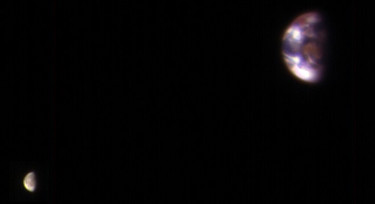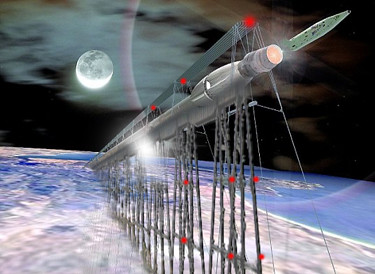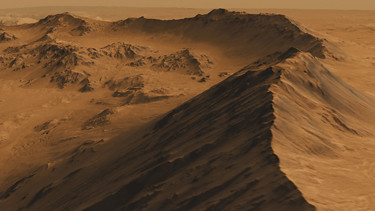
Volume XIX, Issue IVe: Special Book Section
Apollonius
By Bob Kirchman
Copyright © 2020, The Kirchman Studio, all rights reserved
Introduction: A Bit More Reckless Engineering
The establishment of the Alaska Republic in the mid-Twenty-first Century opened up a time of new growth and prosperity for mankind. Tundra farms, biospheres and determination tamed the world's Northernmost frontiers and created homes for millions. Rupert Zimmerman had been one of the initial visionaries but his daughter Elizabeth, his son-in-law Martin and his granddaughter would go even further. The Summer sun never set on the gleaming tower taking shape on Cape Lisbon and crews were working round the clock to complete the gigantic linear accelerator launch complex... a bridge, as it were, to other worlds. On drawing screenpads in Wales, the schematics for the Great Northern, a space ship of epic proportions were being developed. Since the days of Jules Verne, people dreamed of traveling into space and exploring her riches. The American space program set men on the moon in 1969 but there was no economic reason to go further. Great Northern would be built slowly, and the completed ship would be able to make the nine month long journey to the orbit of Mars. There the technology developed to tame the Earth's North; greenhouses and biospheres, would be tested as a means of beginning to terraform the red planet. There were always those thinkers who felt that mankind needed to extend their presence to other worlds to assure survival. Though Zimmerman felt the survival of mankind was in the hands of Someone much higher, he welcomed the investment of such people in the space program.
Indeed; Rupert saw it more as the same need he had first identified in his seven month old granddaughter... the need to go further. The need to move forward! He noticed that the girl was fussy as an infant, but as she learned to push herself up, to roll, and eventually scoot along the floor, she became quite content in her quest for adventure! Humankind seemed created with an almost insatiable need to reach out and that was reason enough for Rupert Zimmerman.
Apollonius
By Bob Kirchman
Copyright © 2020, The Kirchman Studio, all rights reserved
Chapter 1: The Challenge of Moon and Mars
The first man in space, Yuri Gagarin, was reported to have said: “I went up into space, but I didn’t encounter God.” That story was often repeated by the Atheistic Soviet Regime that sent him there and by the Western powers as they refuted the claims of the Soviet regime. His friend, General Valentin Petrov, a professor at the Russian Air Force Academy had a different story. He said of his personal friend the Cosmonaut: “He always confessed God whenever he was provoked, no matter where he was.” Gagarin was a baptized member of the Orthodox Church. Petrov remembered Gagarin saying something quite different in fact: “An astronaut cannot be suspended in space and not have God in his mind and his heart.” It was actually Nikita Khrushchev who had mockingly said: “Why don’t you step on the brakes in front of God?” In the Cold War days the U.S. President, John F. Kennedy, deftly created the civilian space agency, NASA. The struggle to control the high ground of space became recast as a race to the moon and it captured the imaginations of millions. When Gagarin orbited the Earth, the Atheist Empire was dominating. The Russians were depending on immense boosters to go beyond low Earth orbit and when they created the larger multi-engined rocket they needed they couldn’t make it work dependably. Jim Lovell commanded Apollo 8 on a mission to orbit the moon on Christmas Eve in 1968. He read from the Biblical story of Creation. “And God saw that it was good!” The Russians had been lapped.
Apollo 11 landed on the moon and Neil Armstrong and Buzz Aldrin were the first men to set foot on another body in space!, fulfilling Jules Verne’s vision in “From the Earth to the Moon.” They actually celebrated the Lord’s Supper there in the lunar lander before they set foot on the lunar surface! It was an amazing time to be alive. Technological advances created as part of the space program enriched and saved lives as space technology found its way into other areas such as medicine. But the moon itself held no great riches. Men had come, but after Apollo 17 they never returned. Futurists often wrote about colonizing the moon or Mars as a way to ensure mankind survived. NASA, having inspired millions and having brought together incredible talents in the sciences, became another federal bureaucracy and even gave up the capacity to launch men into space. They had to buy rides to the International Space Station from their old competitors, the Russians! After the new world of the North opened up in the wake of the Bering Strait Bridge, mankind again looked to the stars. As money and goods flowed through the new world that had been opened up, there Billionaire George Apollonius was alarmed. His plans for one-world government had been thwarted by the free men and women of the North Country and in his alarm he began to lobby for the nations of the world to terraform Mars, that is make it fit for human habitation. He would have his one-world government… even if it meant building a new world!
But he lacked much of the funding necessary to do it and the engineering ability as well. NASA was but a shell of its former glory and the great advances were being made by Alaska Republic and Israel’s joint space launch complex at Cape Lisbon. Here Apollonius would seek an unholy alliance that would build a ship to take him to Mars. The Zimmerman Organization, for its part, was responding to a concern raised by the leadership of the Alaska Autonimous Republic. They wanted a platform for an enhanced version of Israel’s Iron Dome to protect themselves from rogue nations lobbing nuclear warheads. Space Station/Assembly Center 005 was the platform from which incoming missiles could be detected and destroyed. Its components were initially ferried into orbit by U.S. and Russian Boosters, but of late, the supplying of the station was being accomplished by shuttles launched from Cape Lisbon’s newly completed linear accelerator. Apollonius and Zimmerman had an odd connection, through which began their odd partnership… both were members of London’s Reform Club. Both men traveled quite a bit and were drawn to the club by its association with Jules Verne’s fictional Phileas Fogg, who enters into his famous wager there over a game of whist! Both had been recommended for membership by associates who were in the club and both enjoyed the congenial atmosphere and the fine cuisine.
How goes your work at Cape Lisbon?” Apollonius asked Rupert Zimmerman at dinner one night.
We’ve just begun linear induction launches of small shuttles to our space station.” the old man replied. “Research teams will then ascend to Space Station/Assembly Center 005. We plan to send an unmanned probe to Mars straightway. It will be far more sophisticated than Curiosity.”
Men?, will you then send human explorers?”
No, cost is way out of line with the benefits.”
I needn’t remind you, Mr. Zimmerman, that your precious free world will one day conspire to blow itself up! Where will mankind go when that happens?”
Oh, Mr. Apollonius, I don’t presume so as to think that man can thwart the designs of a loving God toward His Creation!”
Come now!, you are a world leader, even as you avoid title and publicity. You know damn well that God is just a fable for the weak. All that you see is all that there is. What would it take to convince you to team up with me to build a manned mission to Mars?”
I would have to see some benefit that made it worth the risk of human life.”
The survival of mankind is not worth the risk!” Exclaimed Apollonius.
But would you acknowledge, dear Apollonius, that there is more to this universe than you or I can see?” Here Zimmerman secretly wished his friend Jonathan Greene present, but the old man was here quite without his mentor in things unseen. It was Greene who had helped open Zimmerman’s eyes to the Truth he now sought to defend. But Greene was on the other side of the Globe, so to speak. He was in the biosphere town on Big Diomede in the Bering Strait. He was making animal pancakes for his daughter’s breakfast as it was the morning of a school day.
If they are unseen, they can be detected in other ways.” Apollonius responded.
Very well then, if you are an honest inquirer, I challenge you! And I invite you to come to Cape Lisbon and see for Yourself!”
The sun had set in London, but it was rising on Big Diomede on a brand new day. To Zimmerman’s surprise, George Apollonius accepted the offer to travel halfway around the world. “…on one condition. If I can convince you that the journey is worth the risk, you will help me organize a manned mission to Mars!”
(to be continued)
[click to read ]
Copyright © 2020, The Kirchman Studio, all rights reserved

This composite image of Earth and its moon, as seen from Mars, combines the best Earth image with the best moon image from four sets of images acquired on Nov. 20, 2016, by the High Resolution Imaging Science Experiment (HiRISE) camera on NASA's Mars Reconnaissance Orbiter. NASA Photo

The Linear Induction Launch System at Cape Lisbon. [1.]
Terraforming Mars
National Geographic
For some time there has been a fascination with the idea of colonizing Mars.
In 1952, Wernher von Braun wrote a book called "Project Mars" [1.] which imagined that human colonists on Mars would be led by a person called "Elon." Starting with A Princess of Mars [2.] in 1917, Edgar Rice Burroughs wrote eleven novels that portrayed an arid world he called Barsoom made habitable by an “atmosphere factory” (these books were the basis for the recent Disney movie John Carter). The stories in Ray Bradbury’s 1950 collection The Martian Chronicles [3.] were set on a desert planet crisscrossed with canals built by an alien civilization to distribute water from the polar caps. Arthur C. Clarke’s 1952 novel The Sands of Mars [4.] also presents a transformation of the Red Planet to support human life. Kim Stanley Robinson’s Red Mars/Green Mars/Blue Mars trilogy was published in the period of 1992-1996. [5.]

Chasma Boreale, a long, flat-floored valley, cuts deep into Mars' north polar icecap. Its walls rise about 4,600 feet, or 1,400 meters, above the floor. Where the edge of the ice cap has retreated, sheets of sand are emerging that accumulated during earlier ice-free climatic cycles. Winds blowing off the ice have pushed loose sand into dunes and driven them down-canyon in a westward direction. NASA Image

The Orb of Mars. NASA Photo

This is a screen shot from a high-definition simulated movie of Mojave Crater on Mars, based on images taken by the High Resolution Imaging Science Experiment (HiRISE) camera on NASA's Mars Reconnaissance Orbiter. A 3-D surface model was created using stereo pairs from the HiRISE camera. Mojave Crater has a diameter of 60 kilometers (37 miles). NASA Image
